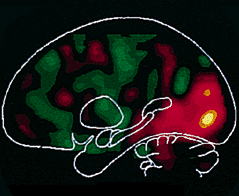

|
Video
Clip: |
You will need to install RealPlayer in order to view the clips.
PET scan of a brain "in action": the person is seeing words
PET
Scan
(by Alison Wright)
Particle physicists regularly use collisions between electrons and their antiparticles, positrons, to investigate matter and fundamental forces at high energies.
When electron and positron meet, they annihilate, turning into energy which, at high energies, can rematerialise as new particles and antiparticles. This is what happens at machines such as the Large Electron Positron (LEP) collider at CERN.
At low energies, however, the electron-positron annihilations can be put to different uses, for example to reveal the workings of the brain in the technique called Positron Emission Tomography (PET).
In PET, the positrons come from the decay of radioactive nuclei incorporated in a special fluid injected into the patient. The positrons then annihilate with electrons in nearby atoms. As the electron and positron are almost at rest when they annihilate, there is not enough annihilation energy to make even the lightest particle and antiparticle (the electron and the positron), so the energy emerges as two gamma-rays which shoot off in opposite directions to conserve momentum.


